It was -8° when I woke up on the day we were scheduled for a five hour walk along the Great Wall and I don’t mind telling you my heart sank when I saw the temperature. Fortunately, it’s ok to keep reading. This story has a happy ending, because the sun came out and it turned out to be a beautiful day.
(Pause for Great Wall facts and history, cribbed from the LP):
The Great Wall was first started over 2,000 years ago when China was unified under Emperor Qin Shi Huang. Different sections of wall had been constructed by independent kingdoms prior to unification, and under Qin Shi Huang these were linked together by the efforts of hundreds of thousands of workers working for ten years. Its original purpose was to keep out marauding Mongol invaders from the north. It never really did that, but it did become a sort of elevated northern highway assisting in the movement of goods through the mountainous terrain. It fell into disrepair but was refurbished during the Ming Dynasty in a one hundred year long project that refaced a lot of the wall with brick and stone. However, despite its pretty new exterior, the Wall did nothing to stop the Manchu invaders in the 1640s who went on to form the Qing Dynasty and rule China for about 200 years, until the last emperor (yes, that “Last Emperor”) abdicated in 1912.
But enough history – let’s have some pictures! I took a lot of pictures of the Wall, but it’s really hard to convey exactly how LONG it really is if you don’t see it for yourself. It stretches for more than 5,000 kilometers. FIVE THOUSAND. That’s about the length of the Trans Canada highway from Edmonton to Halifax.
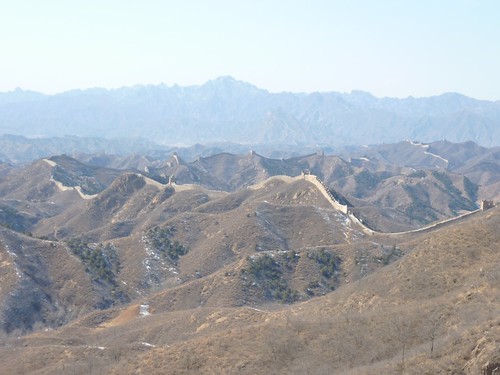 This sort of gives you an idea of how long the wall is – it just keeps going farther than you can possibly see.
This sort of gives you an idea of how long the wall is – it just keeps going farther than you can possibly see.
And we’re not talking about a six foot high picket fence here. The Wall varies in width – in sections where its broken down it might only be four or five feet wide. But in the restored parts it’s at least eight to ten feet wide most of the time. It’s stone and brick on the outside, but it’s filled with rammed earth. Apparently, part of the Wall’s decline over the years is due to local farmers cannibalizing the earth in the core to supplement their fields.
 Look closely and you can see a few of the gang heading up a set of stairs. This was an averagely wide section.
Look closely and you can see a few of the gang heading up a set of stairs. This was an averagely wide section.
Also central to the design of the Wall is the many (MANY) towers along its whole length. Because the wall was built for defensive purposes, the towers gave somewhere for guards to be posted, and somewhere that signal fires could be lit. And because there’s a lot of wall, there are also a lot of towers. Our walk was about 10km and we passed through thirty towers. That means there’s about three towers per kilometer, making about 15,000 in total. Most in the touristed sections have been restored, but others are crumbling, and still others have almost disappeared.
Our walk started at the Jinshanling Wall, near the town of Gubeikou, and proceeded in what the LP calls “an exhilarating 10km hike to Simatai. (Note: the Anglicized forms of all these Chinese names have loads of accents and things on them in an attempt to convey the different tones of all the vowel sounds. I honestly can’t be bothered to hunt and peck in the Windows Character Map to find them all, so just tough it.) And it actually was pretty exhilarating. There are some very very steep sections, as you can see from the photos. The Wall hugs the top of a range of hills, so whenever the lands rises, so does the wall. If the lands rises sharply, the steps get steeper and steeper. Some of the steps were about two feet high, and only ten to twelve inches deep. And though the sun was out and the day was relatively warm, there were still snow-covered and icy sections, so it wasn’t just the view that was exhilarating.
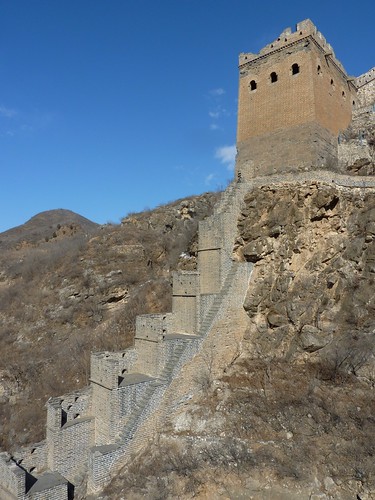 A very steep bit of wall, heading down into the river gorge at Simatai.
A very steep bit of wall, heading down into the river gorge at Simatai.
At around the halfway point (I think it was Tower 13), we stopped and ate a picnic lunch. It was nice, but also a bit annoying because we weren’t alone. Surprisingly, the problem was not other tourists; we didn’t see another tourist until we were almost finished the walk. The trouble was that as soon as we arrived at the parking lot to start our trek we attracted a crowd of about six to ten local who followed us, literally for hours hoping to sell us cold drinks, post cards, t-shirts or other tourist tat. They were supplemented by others we met who were already out on the Wall, so sometimes we were actually outnumbered. And some of them were incredibly persistent. One old woman targeted Tony, the only Asian in the group, and pestered him for the whole break. He finally relented and bought some postcards.
 A very steep set of stairs, and some of the gang of hawkers who followed us for hours.
A very steep set of stairs, and some of the gang of hawkers who followed us for hours.
Really, you had to admire these people. A lot of them were not young. Tony’s woman must have been over sixty. And the conditions on the Wall are not easy – as I mentioned, it was steep and icy and we were out there for hours. The old guy below was particularly impressive – he claimed to be 72 years old. I bought a drink from another guy who was camped out in one of the towers. I ignored him when I walked past at first because he was just chanting the same old, “Cold drinks, coke, water” that I’d heard many times before. Then one half-heard word caught my attention, and I pulled up short. “Did you say BEER?” I asked. “Beer. Beer. Yes.” The deal was struck in an instant, and though the price – ¥10 – was double what it would be in town, I paid it happily. And it was nice and cold!
 The 72 year old hawker who sold David an outdated can of Coke.
The 72 year old hawker who sold David an outdated can of Coke.
Most of our walk was spent on the Wall of course, but there were some sections where we left it in order to avoid a particularly steep or broken down area. It was nice to stroll along the dirt paths too, and to see the Wall from a different perspective.
After lunch it was a relatively short walk to the end of our path, though of course the Wall kept going, because that’s what it does. Our walk ended at Simatai, which turned out to be the site of a dam. They had a zip line set up that let you skip the last fifteen minutes of walking in favour of a quick ride across the river valley on a cable. Normally I’m up for that kind of thing, but something about the somewhat dodgey and abandoned feel of the set-up gave me pause, and I decided to skip it. However, nine of our number did take the plunge, and nine made it to the bottom unscathed, so it turned out to be fine.
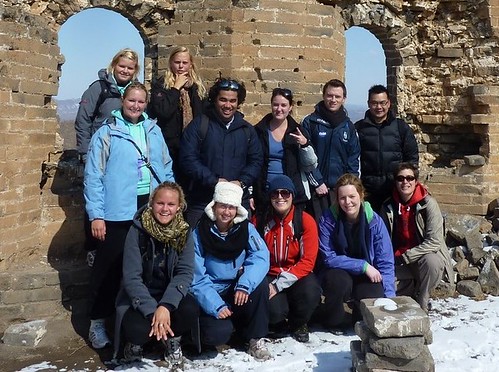 All still present and accounted for, here’s the new gang on the Great Wall. I would tell you everyone’s name, but I am embarrassed to admit that after four days I still can’t tell the Danes apart.
All still present and accounted for, here’s the new gang on the Great Wall. I would tell you everyone’s name, but I am embarrassed to admit that after four days I still can’t tell the Danes apart.
In the end it didn’t take us five hours to complete our walk, and I was grateful for that. My legs were still a bit tender from that challenging hash run on Sunday, so while it felt good to work some of the kinks out, I was ready for a rest by the time the end was near. The bus ride back to Beijing was longish, but not too long. And that night I had Beijing Duck and an early bed time, and the next morning I got to sleep in. So as I said, it was a happy ending.
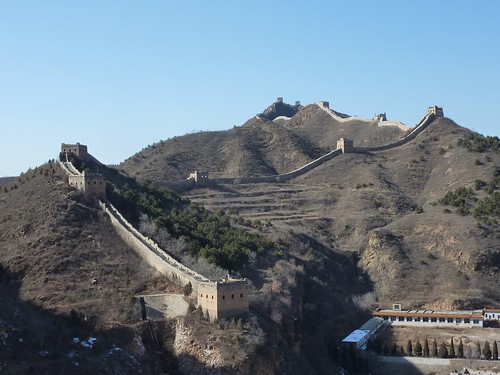 More Wall, heading past the point where my path and its diverged again. I told you it just keeps going.
More Wall, heading past the point where my path and its diverged again. I told you it just keeps going.

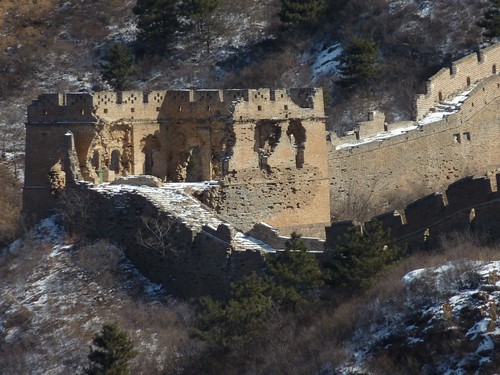
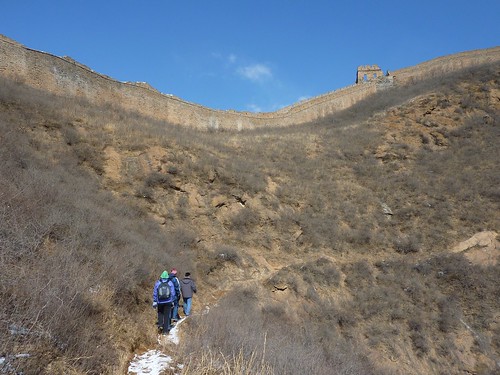


2 Comments:
Hi Pam,
Sounds like you are having fun - I think Fabio would have been better suited to this tour! I saw Jam and some others from the Syrian trip last night and it was good to catch up. I am off on my 2 and a half months trip on Sunday, looking forward to it and I've packed better this time!
Emma
Your Liza-Minelli-plays-Spock hairdo is totally gone! But the images I had after that description were probably waaaaaaay worse than the cut...
I love these pictures...one of my dreams is to run the Great Wall Marathon...So many dreams - so little time...
Onward Pam!!!
Post a Comment